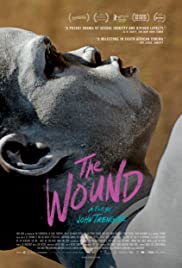
INXEBA/ THE WOUND
South Africa, 2017, 89 minutes, Colour.
Nakhane Toure, Bongile Mantsai, Niza Jay Ncoyini.
Directed by John Trengove.
In this case, the wound is circumcision, male circumcision. The setting is an initiation period for young Xhosa tribal men who go into the mountains for a week of ceremonies to make them into men. Circumcision also stands as a symbol for many of the themes of the film, focused on the male sexual member, the notion of manhood, maleness.
However, at the centre of the film is a worker in a factory, Xolani, called X, a man who might have gone on to studies but has opted for a working life. Each year, he volunteers to go into the mountains to be one of the carers for the initiates. This year he has been asked by a businessman from Johannesburg to be the carer for his son – whom the father considers to be “soft�, and wants him to become a stronger man.
This time there are ten initiates, and three of them have as their carer, Vija, a regular at the ceremonies, a married man with children, but a close friend of X.
The director is a white South African and there was some criticism that this was a white outsider’s view of initiation ceremonies and circumcision. However, John Trengove is a South African and had Xhosa writing collaborators for his screenplay.
On the one hand, the initiation ceremonies are taken very seriously. On the other, those who preside over the rituals are a group of very ordinary men, workers, fathers, supervised by a medical man. It should be noted that the actual circumcision sequences are quite graphic, not so much visually, as visceral. The young men endure the ritual with quite some stoicism, having to declare frequently that they are men. However, the recuperation is severe, herbs and lotions, bandages, slow healing, camping out in the countryside.
But the film is also about realities of homosexuality amongst the tribal men. X is a gay man, living alone, a lonely man, encountering Vija each year, Vija being sexually ambiguous in his behaviour. Homosexual behaviour is frowned on by the community and the initiates, despising the soft young man from the city, insult him as a faggot, but there is never any explicit indication that he has a gay orientation.
This means that on the one hand, there is an almost documentary-like presentation of the initiation and the circumcision. And that, on the other hand, there is a personal drama, struggles with sexual orientation and behaviour, condemnation, the need for secrecy – which leads to dramatic torment for X and the young initiate confronting him and leading to tragedy.
The film was South Africa’s Oscar-nomination. It is quite a powerful film, highly critical of the circumcision (not necessarily of initiation rites), very demanding on its audience, emotionally, viscerally, psychologically.
1. South African story? Tribal? Men’s initiation?
2. The locations, the atmosphere in South Africa, for black Africans, the factories, the road, the hills, the initiation ceremonies, the camp, the mountains and waterfall, the references to Joburg?
3. The musical score, the songs, the rituals?
4. The title, the focus, circumcision for men, as an initiation rite? The pain? The cutting? The declaration that they were men? Herbs and lotions for remedy and recovery?
5. The film and the fact of circumcision? Circumcision as a symbol, the male member, masculinity, sexual aspects, transitions?
6. X, his work in the factory, the forklift, his age, character, living alone, choosing work rather than study? The father and the commission of the initiation of his son? The son living in Johannesburg, considered soft? X’s commitment?
7. The range of carers, the group, their task, participation, guides, presence at the rituals, at the recovery, the seclusion in the countryside for many weeks?
8. The initiates, the group, their age, tribal background, the ritual clothing, the cutting, their being together? Camaraderie? Kwanda and his being an outsider, from the city, labelled as a faggot?
9. Vija, his role as a carer, with the initiates, his background, wife and family? His friendship with X? Over the years, the annual meeting, the sexual relationship, his denial? The experiences of tension, anti-homosexual prejudices?
10. The elders, ordinary men, upholding the traditions, continuing them? The children interviewing kinder – and the envy of his iPad?
11. The scenes of the cutting, the visual impact?
12. X, Kwanda, their talking, discussions about sexuality, the discussions, the care, Kwanda’s attitudes? Kwanda and his life and his aims?
13. The waterfall, the sequences there, the group walking, the fence? The return to camp?
14. X, his going and coming, the discussions with Vija, the sexual encounter and Kwanda finding them?
15. Plans for the following year, Vija and his return, X and his questions?
16. Homosexuality, traditions, community, the impact on each? X and secrecy?
17. X and Kwanda, climbing the mountain, the threats of exposure, X pushing Kwanda over the cliff?
18. His future?
19. Audience interest in tribal life, initiations, circumcision? Entering into this world – and dealing with it?